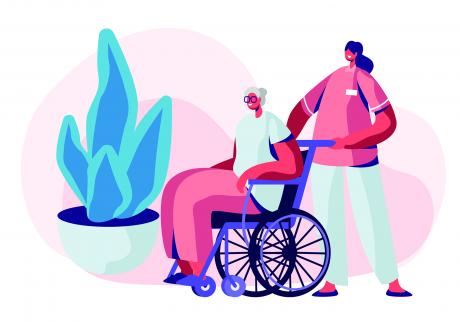Abstract
Homelessness among older adults is increasing; among single homeless adults, approximately half are ages 50 and older. Of these, almost half first became homeless after age 50. Adults ages 50 and older who are homeless are experiencing health conditions—including cognitive and functional impairment—20 years earlier than their housed counterparts. They often use costly acute healthcare services, and die prematurely. Ending homelessness among older adults will require increasing the supply of affordable housing, targeted prevention efforts, and expanding permanent supportive housing, adapted to older adult needs.
Key Words:
older adult homelessness, poverty, affordable housing, racial justice, SSI, SSDI
Homelessness has devastating effects on people’s health and spirits, whether they live in a tent, a vehicle, or a homeless shelter. While there has been ample media attention on homelessness, recently, less attention has been paid to the news that the homeless population is aging. In the early 1990s, 11 percent of homeless single adults were ages 50 or older. By 2003, 37 percent were. Now, approximately half are. People ages 65 and older are the fastest growing age group of people who are homeless; by 2030 their numbers will triple (Culhane et al., 2019). While homelessness is devastating for all, older adults face additional risks and harms from the experience.
The fundamental cause of homelessness is poverty, the lack of affordable housing, and the ongoing effects of structural racism. According to the Harvard Joint Center on Housing, people older than age 50 have the highest risk of paying more than 30 percent of their income on rent or mortgage (Joint Center for Housing Studies of Harvard University [JCHS], 2018). One half of renters ages 50 and older in the United States pay more than 30 percent of their household income on rent. Paying this much for housing means cutting back on other expenses, including healthcare, transportation, and healthful food.
Low-income people who spend more than 30 percent of their income on rent are unable to save money, leaving them vulnerable to losing their housing when they face setbacks, such as a job loss, sickness, or death of a spouse or partner.
At its heart, the homelessness crisis is due to lack of affordable housing for the lowest income Americans. Existing housing stock with lower rents has declined across the country, and few newly constructed properties rent at levels affordable to lower-income individuals (JCHS, 2019). People who are extremely low income (ELI), i.e., they make less than 30 percent of the Area Median Income, are at the highest risk of homelessness. Nationally, there are only thirty-five units of housing that are available and affordable for every 100 ELI households (Aurand et al., 2019). Without fixing the dramatic lack of housing for low-income adults, we will not be able to end the homelessness crisis.
‘The fundamental cause of homelessness is poverty.’
Ending homelessness is a racial justice issue. Black Americans are at significantly higher risk for homelessness than white Americans, due to the ongoing effects of structural racism. Discrimination in housing markets, through practices such as residential covenants and redlining (which restricted Black households from obtaining mortgages and enforced residential segregation), contributed to the enormous racial wealth gap between Black and white households (Rothstein, 2017). Poor enforcement of Fair Housing Act policies leads to Black households paying more for the same type of housing than white households (Desmond, 2016). Banks targeted Black and Latinx households for predatory lending practices during the foreclosure crisis in 2008. Add to this ongoing and well-documented discrimination in the criminal justice system, educational system, and employment, and it is not a surprise that Black Americans nationally are at a three-to-four-fold increased risk of homelessness (Moses, 2019). To address homelessness, we must reckon with the lingering effects of structural racism.
Homelessness Research Reveals Lifelong Struggles or Recent Setbacks
To understand the life experience of older adults who experience homelessness, my research group has been following a group of adults, who, at study entry, were ages 50 and older and homeless in Oakland, California. We have been checking in on participants every six months since 2013–2014, asking whether or not they have regained housing. Our study, named the “Health Outcomes for People Experiencing Homelessness in Older Middle agE” (HOPE HOME), found that almost one-half had never experienced homelessness prior to the age of 50. Participants with a first episode after age 50 differed from those who had been homeless earlier in life and remained homeless in older middle age (Brown et al., 2016).
Those with early onset homelessness reported extraordinarily challenging childhoods, replete with significant adverse experiences. Due to these challenges, these individuals had struggles throughout their lives. Many had developed mental health and substance use disorders early in life, had limited formal education, and had spent significant time incarcerated. These individuals had struggled throughout their lives, including enduring long stretches of homelessness that persisted into later life.
Individuals with late onset homelessness had very different stories. While almost all of these study participants had lived in poverty throughout their adult lives, they had long work histories, usually in low-paying, physically demanding work. These men and women reported that sometime, after age 50, they experienced a setback: the breakdown of a marriage, a job loss or illness (theirs, or their spouse or partner), or the death of their spouse, partner, or parent. With little savings, facing difficulty finding work as an older adult, and having little ability to compete in an unforgiving housing market, they faced homelessness for the first time.
Understanding these different pathways to homelessness can guide our efforts to prevent and end homelessness. No matter whether the older homeless adults had faced homelessness for many years, or whether they experienced their first homelessness after age 50, the consequences are devastating.
Homelessness is deeply traumatizing—to everyone, but even more so for frail older adults. We found that 11 percent of older homeless adults reported experiencing sexual or physical assault in the prior six months—this risk dropped by half when the participants regained housing (Tong et al., 2019). We found a high prevalence of geriatric conditions—cognitive impairment (difficulty remembering, following directions), functional impairment (difficulty with bathing, toileting, dressing, and the like), sensory impairments (hearing and vision loss), and problems such as falling and urinary incontinence—at a level higher than we see in people in the general community in their 70s and 80s (Brown et al., 2017).
Many individuals struggled with multiple chronic health problems, such as heart disease, chronic lung disease, and cancer—while living outside. Older homeless adults use acute healthcare services such as emergency departments and inpatient hospitalizations at high rates. Also we have found high rates of nursing home stays, which may have been preventable had the individuals had housing. And we have found extraordinarily high death rates—even higher in those who first became homeless later in life. The most common cause of death in these adults was similar to that among housed older adults: cancer and heart disease. However, these deaths occur approximately twenty years earlier. All of this speaks to the unbearable challenge of homelessness among older adults—and the urgent need for action.
Solutions to Prevent Homelessness
What are the solutions? We know how to solve homelessness, but lack the political will to do so. First, we need to close the housing affordability gap. By increasing the supply of housing that is affordable to ELI populations, we can reduce homelessness. With only thirty-five units of housing affordable and available for every 100 ELI households, it will be difficult to end homelessness. Not only does meager affordable housing stock increase vulnerability to homelessness, but also it decreases the chance of becoming housed. Closing the ELI housing gap will take focused efforts at all levels of government, and a population that demands that their elected officials close that gap.
‘Relatively small commitments of money and other assistance during a crisis can prevent homelessness.’
Another key strategy to improve housing affordability is to increase the availability of rental assistance. Nationally, only one in four households that meets the criteria for rental assistance receives it. Among older adults, that number increases to one in three. Rental assistance is not an entitlement, and the various federal programs that provide affordable rental opportunities are not funded to meet the demand. Housing Choice Vouchers (referred to colloquially as Section 8 vouchers), the largest federal rental assistance program, allows recipients to rent housing on the free market and pay 30 percent of their household income on rent. The voucher pays the rest.
Expanding access to Housing Choice vouchers would have an immediate positive effect on homelessness, affording stability to households to remain in their housing, and allowing people who are experiencing homelessness to exit it. It is estimated that the United States could fully fund the Housing Choice Voucher program with an additional outlay of $31 billion a year (Khadduri, 2020). Right now, the United States spends an estimated $12 billion on homeless shelters (Cooper, 2019)—and even so, a large proportion of people experiencing homelessness remain unsheltered.
To prevent and end homelessness, we need to increase income and protections for low-wage workers and those with disabilities. The federal minimum hourly wage of $7.25 has not kept up with inflation. It is worth 15 percent less than it was, when last raised, in 2009, and 29 percent less than it was at its peak value in 1968. Older adults who have worked minimum wage jobs throughout their lives remain highly vulnerable to homelessness.
Supplemental Security Income (SSI) and Social Security Disability Insurance (SSDI), two federal programs that provide income to people with disabilities that make them unable to work, who are blind, or older than age 65 and having limited income and resources, can play an important role in ending homelessness. SSI income is very low: the Federal benefit is $783 a month. States are allowed to supplement this, and all but four do, with supplements ranging from $10 to $400 a month. Increasing SSI or fully funding the State supplement could help older adults and those with disabilities to afford housing.
People experiencing homelessness may have difficulty accessing benefits for which they are eligible. Programs such as SOAR (SSDI Outreach, Access, and Recovery—a national program designed to increase access to the disability income benefit programs for eligible adults who are experiencing or at-risk of homelessness and have a mental illness, medical impairment, and-or a co-occurring substance use disorder) provide help in doing so, and should be expanded.
Increasing eviction protections and renters’ rights also can help reduce homelessness. Actions can include limiting evictions without just cause, providing access to attorneys in eviction cases, or prohibiting discrimination based on renter’s source of income or eviction history, among others (National Law Center on Homelessness & Poverty, 2018). Providing financial assistance to help households pay back rent can also help prevent homelessness (National Alliance to End Homelessness, 2006).
Understanding the precipitants of homelessness in late life: job loss, marriage break-up, illness in self or spouse, or death of spouse or parent—could help to direct prevention efforts. Because many older adults live on fixed incomes, another strategy to prevent or end homelessness is to use shallow subsidies (typically several hundred dollars a month of limited, needs-based payments). Some cities are exploring the use of shallow subsidies to keep older adults housed (Sharma, 2019).
As individuals age, in housing, or while homeless, services will have to adapt to their needs.
For the older adults who first experience homelessness in late life, these efforts—increasing affordable housing, increasing income, and providing effective homelessness prevention opportunities—may be enough to prevent and end homelessness.
Solutions for Long-term Homelessness
What about older adults with significant mental health and substance use disabilities and long histories of homelessness? For these individuals, Permanent Supportive Housing (PSH), offered using Housing First principles, is a highly effective solution to homelessness (Chung et al., 2018). PSH refers to affordable housing coupled with voluntary supportive services. Housing First refers to the strategy to place no preconditions on the housing, such as sobriety or engagement in mental health care. PSH has been shown to be enormously successful in housing chronically homeless individuals with behavioral health disabilities, with upwards of 85 percent of these individuals achieving successful housing (Perl and Bagalman, 2015).
Through the use of PSH, the Veterans Administration has seen dramatic reductions in chronically homeless veterans (United States Interagency Council on Homelessness, 2018). Small studies such as that by Bamberger and Dobbins (2015) have suggested that many formerly homeless older adults who were placed in nursing homes could be housed successfully in PSH, at lower cost and with more independence.
As individuals age, whether in housing, or while homeless, services will have to adapt to their needs. A major issue for PSH residents is the need for aging-appropriate services, such as personal care, dementia care, and hospice and palliative care. There are promising models to adapt low-income and supportive housing for the needs of older adults. The Community Aging in Place (CAPABLE) model employs a visiting nurse, an occupational therapist, and a handyperson for low-income older adults, who are given resources to do home improvements recommended by the team (Henwood, 2019).
This model has been shown to help keep older low-income adults in their home and is being adapted for PSH. Other promising models are the co-location of Program of All-inclusive Care for the Elderly (PACE) programs within PSH, which can help to address the complex medical, functional, and behavioral health needs many homeless older adults face (PACE, 2020). Some older adults need more care than PSH can provide. Some will thrive in residential care facilities, such as board and care homes, which provide supervision, personal care, and meals. The loss of these options from many areas has created a gap in care for low-income older adults. Others will require nursing home care, but nursing home care should be reserved for those who cannot thrive in the community, not as an escape from homelessness.
No place should tolerate older adults spending the last years of their life homeless. In a country as wealthy as the United States, homelessness for anyone—but particularly older adults—is unconscionable. However, without dedicated effort, it will continue. We have the means to end homelessness in older adults. By increasing affordable housing for older adults, engaging in targeted prevention efforts, and building off the success of permanent supportive housing, we can make homelessness for older adults rare and brief. The shocking increases in older adults experiencing homelessness should compel us all to action.
Margot Kushel, M.D., is a professor of Medicine at University of California at San Francisco and director of the UCSF Center for Vulnerable Populations and UCSF Benioff Homelessness and Housing Initiative.
References
Aurand, A., et al. 2019. “The Gap: A Shortage of Affordable Rental Homes.” National Low-Income Housing Coalition. tinyurl.com/rz2n2c2. Retrieved January 21, 2020.
Bamberger, J. D., and Dobbins, S. K. 2015. “A Research Note: Long-Term Cost Effectiveness of Placing Homeless Seniors in Permanent Supportive Housing.” Cityscape 17(2): 269–77.
Brown, R. T., et al. 2016. “Pathways to Homelessness Among Older Homeless Adults: Results from the HOPE HOME Study.” PLOS ONE 11(5): e0155065.
Brown, R. T., et al. 2017. “Geriatric Conditions in a Population-Based Sample of Older Homeless Adults.” The Gerontologist 57(4): 757–66.
Chung, T. E., et al. 2018. “Housing First for Older Homeless Adults with Mental Illness: A Subgroup Analysis of the At Home/Chez Soi Randomized Controlled Trial.” International Journal of Geriatric Psychiatry 33(1): 85–95.
Cooper, A. 2019. “Rent Is Obscene Here”: The Issues Forcing People in Seattle Onto the Street.” tinyurl.com/ycea4t3o. Retrieved June 10, 2020.
Sharma, A. 2019. "Santa Monica To Subsidize Rent For Hundreds Of Seniors." LA Ist, Aug. 20. tinyurl.com/y9nomopu. Retrieved January 22, 2020.
Tong, M. S., et al. 2019. "Persistent Homelessness and Violent Victimization Among Older Adults in the HOPE HOME Study." Journal of Interpersonal Violence. tinyurl.com/ybvm2vk8. Retrieved April 24, 2020.
United States Interagency Council on Homelessness. 2018. Homelessness in America: Focus on Veterans. tinyurl.com/y43w3k8v. Retrieved April 27, 2020.





